There has been a world-wide decline in prevalence of dental caries because of the use of fluoridated toothpastes [1]. Despite the use, dental caries is still prevalent in most of the developing countries. There is enough evidence which shows that fluoridated toothpaste is effective in reducing dental caries [1-4]. Greater the concentration of fluoride in toothpaste, the more strong the tooth structure will be [5]. Despite the benefits, the fluoride content in the toothpastes must be controlled as it has a potential risk of developing dental fluorosis [6].
A previous study showed that commercially available toothpastes only label the content of TF in toothpastes and not the TSF concentration. But the TF present in the toothpaste is not available as some of the fluorides such as sodium fluoride, stannous fluoride will get combined with abrasives that contain calcium present in the toothpaste [7]. Due to the incompatibility of sodium fluoride, stannous fluoride with calcium-based abrasives, silica abrasives have been used to encounter this effect. In such formulations, fluoride should be chemically soluble to have an anticaries effect [8]. The beneficial effect against dental caries is due to the presence of TSF. The availability of soluble fluoride is essential to interfere with the caries process thereby reducing enamel demineralisation and enamel remineralisation [9]. Amount of bioavailability in toothpaste depends on the type of fluoridated agent and abrasive used [8]. The presence of fluoride is usually affected by the various constituents of toothpaste which may sometimes leads to fluoride insolubility. Therefore, it is important that the chemicals present in toothpaste should be compatible for maximum fluoride availability [10].
The pH balance in oral cavity plays a crucial role to help fight off dental caries. The oral cavity must maintain pH of at least 5.5 known as critical pH below which demineralisation occurs. So, it is necessary to use toothpaste with correct pH that will help to neutralise acidic activity of oral cavity, thereby providing healthy environment for teeth [11]. There is enough evidence on the anticaries effect of fluoride but little attention is paid to the pH levels in the toothpaste [12]. As there is a certain discrepancy in the TSF concentration present in the toothpastes and the TF concentration reported by the manufactures in toothpastes [13], it is therefore necessary to determine the TF and TSF among various brands of toothpastes. Hence, this study aimed at assessing the concentration of TF, TSF and the pH among various brands of toothpaste available in the market.
Materials and Methods
An in-vitro study was designed to determine and compare the TF, TSF and pH of various toothpaste samples. Analysis of the samples was done at the Department of Environmental Engineering Laboratory, National Institute of Technology, Surathkal, Karnataka, India. The study was conducted during the month of October 2019 after taking prior permission from the respective authorities of the National Institute of Technology, Surathkal, Mangalore.
Prior to the start of the study, various brands of commercially available toothpastes were obtained based on convenience and on their availability in the local market. Samples consisted of 20 toothpastes from which five toothpastes were included in four different groups: Herbal toothpastes, Nonherbal toothpastes, Medicated toothpastes and Kids toothpastes. Prior to analysis, the toothpaste tubes were covered with masking tape to conceal the toothpaste brand and group. The concealed toothpaste tubes were then coded with letters from A-T to allow blind analysis.
Determination of Total Fluoride (TF) and Total Free Fluoride Concentration
Two forms of fluoride present in the toothpaste were determined: TF and TSF.
TF is the sum of TSF plus Insoluble Fluoride (InF). InF is the fluoride that is bound to the abrasive.
Total Soluble Fluoride (TSF or free fluoride) is the fluoride which represents ionic fluoride {IF+F as Mono Fluoro Phosphate (MFP) ion} [14].
Procedure: Fluoride analysis was carried out according to a protocol modified from Pearce EI [15]: 90-110 mg of toothpaste was weighed using a Weighing Machine (+0.01 mg) [Table/Fig-1] and homogenised with 10 mL of distilled water [Table/Fig-2] to create a suspension, from which different fluoride fractions were obtained.
A 90-110 mg of toothpaste was weighed.
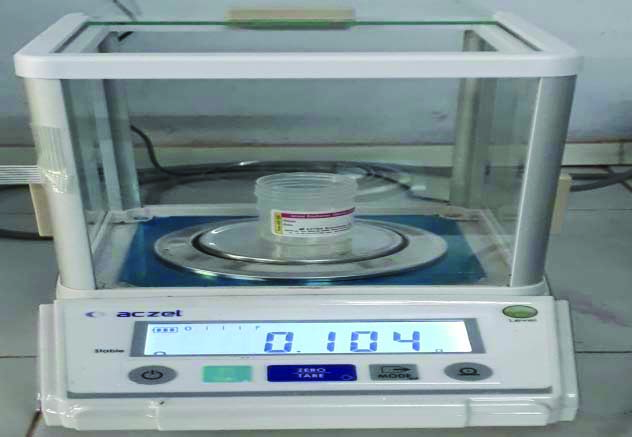
The toothpaste was homogenised with 10 mL of distilled water.
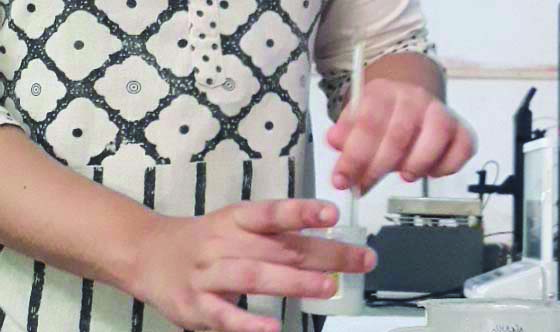
Total Fluoride [TF] [10,15]: A 0.25 mL of the suspension was transferred to the test tubes [Table/Fig-3] and 0.25 mL of 2.0 M hydrochloric acid was added to break MFP ion into fluoride ion to dissolve InF bound to the abrasive [Table/Fig-4].
A 0.25 mL in duplicate of the suspension were transferred to test tubes.
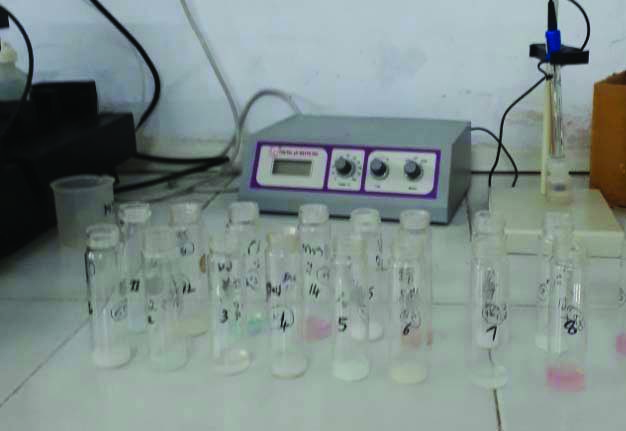
A 0.25 mL of 2.0 M hydrochloric acid was added to break mono fluoro phosphate ion into fluoride ion.
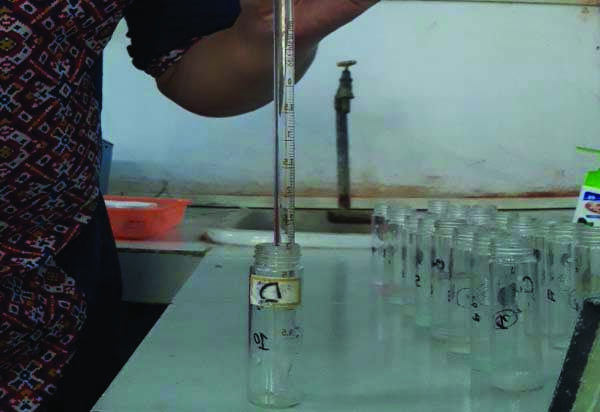
Acidified suspension was maintained for one hour at 45°C and neutralised using 0.5 mL 1.0 M sodium hydroxide, followed by 1 mL Total ionic strength adjustment buffer II (1.0 M acetate buffer, pH 5.0, containing 1 M sodium chloride, and 0.4% 1,2-cyclohexanediamine Tetraacetic acid low sodium (CDTA).
Total Soluble Fluoride [TSF] [10,15]: To remove InF bound to abrasive, dentrifice suspension was centrifuged using a high speed centrifuge for 10 minutes at 3000 grams [Table/Fig-5] to 0.25 mL of the supernatant, 0.25 ml of 2.0 M hydrochloric acid was added to break MFP ion into ionic fluoride and the tubes were kept in a hot air oven for 1 hour at 45°C [Table/Fig-6].
Dentifrice suspension was centrifuged (10 min at 3000 g) at room temperature.
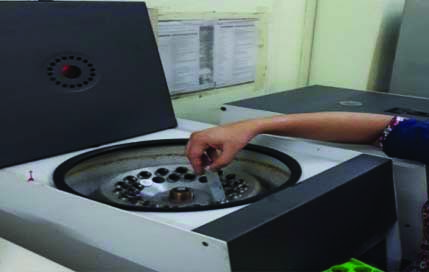
0.25 mL of the supernatant, 0.25 mL of 2.0 M hydrochloric acid was added and the tubes were kept in a hot air oven for 1 hour at 45°C.

Acidified solution were neutralised with 0.5 mL of 1M sodium hydroxide [Table/Fig-7] followed by 1.0 mL Total ionic strength adjustment buffer II (1.0 M acetate buffer, pH 5.0, containing 1 M sodium chloride, and 0.4% 1,2-cyclohexanediamine Tetraacetic acid low sodium (CDTA)) [Table/Fig-8].
Acidified solution were neutralised with 0.5 mL of 1M sodium.
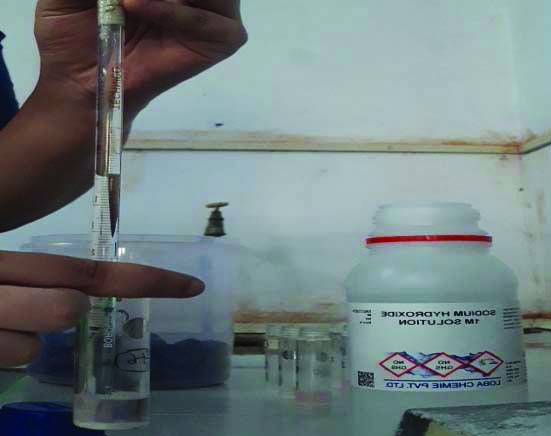
The suspension was further neutralised with 1 mL Total ionic strength adjustment buffer II.
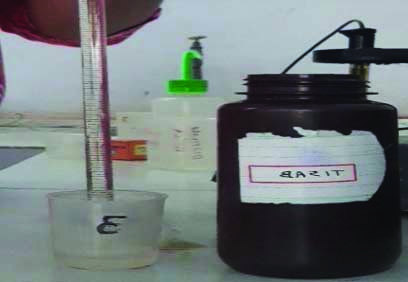
Assessment of fluoride: Fluoride concentration was determined using a Fluoride electrode (Orion model 96-09, Orion research, Cambridge, MA) coupled to ion analyser (Orion EA-70). Fluoride electrode was calibrated with Fluoride standards made with the same reagents to prepare the samples [Table/Fig-9].
Fluoride concentration was determined fluoride electrode coupled to anion analyser (Orion EA-70) was used.
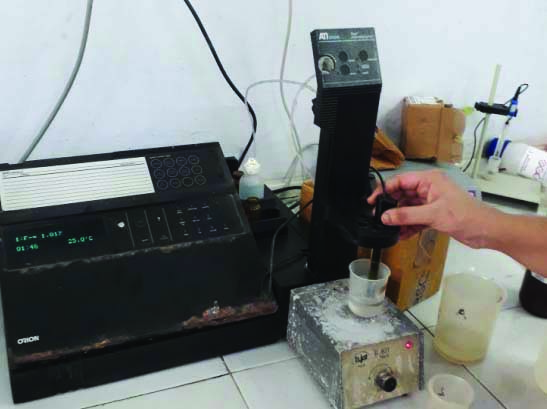
pH Determination
pH was determined after the determination of fluoride concentration in each toothpastes.
Procedure: A 10 grams of toothpaste was dispensed in a 50 mL beaker and was homogenised with 10 ml of distilled water, to make 50 percent aqueous suspension. The pH of the suspension was determined within 5 minutes using pH meter [Table/Fig-10] [16].
pH of the suspension was determined using pH meter.
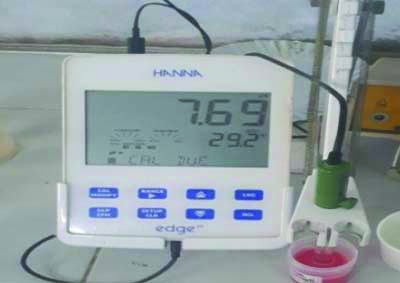
Statistical Analysis
Data was entered in a excel sheet and statistical analysis was done using SPSS for Windows, version 19.0, SPSS Inc., Chicago, IL, USA. Descriptive statistics such as mean and standard deviation was done. Analysis of Variance (ANOVA) was done followed by Tukey’s post-hoc test to determine the significant difference between the groups. The level of significance was set at 0.05.
Results
Among the herbal toothpastes, colgate sensitive with clove oil toothpaste had the highest concentration of TF as well as TSF concentrations of 977 ppm and 870 ppm, respectively. The pH was found to be highest in Colgate active Neem salt toothpaste [Table/Fig 11].
Herbal toothpastes concentrations among various groups of toothpastes.
| Herbal toothpastes | Fluoridated agent | Total fluoride (ppm) | Total soluble fluoride (ppm) | pH |
|---|
| Himalaya complete care toothpaste | NaMFP | 400 | 391 | 6.34 |
| Colgate sensitive with clove oil toothpaste | NaF | 977 | 870 | 8.49 |
| Neem active toothpaste | NaMFP | 450 | 400 | 9.07 |
| Colgate active neem salt toothpaste | NaMFP | 895 | 855 | 9.56 |
| Colgate herbal toothpaste | NaF | 800 | 700 | 9.30 |
NaMFP: Sodium mono fluoro phosphate; NaF: Sodium fluoride
Among the nonherbal toothpastes, colgate total 12 toothpaste had the concentration of TF as well as TSF concentrations of 1220 ppm and 1210 ppm, respectively. The pH was found to be highest in sensodyne rapid relief toothpaste [Table/Fig-12].
Nonherbal toothpastes concentrations among various groups of toothpastes.
| Nonherbal toothpastes | Fluoridated agent | Total fluoride (ppm) | Total soluble fluoride (ppm) | pH |
|---|
| Sensodyne deep clean toothpaste | NaF | 950 | 900 | 7.69 |
| Colgate total 12 toothpaste | NaF | 1220 | 1210 | 7.77 |
| Sensodyne rapid relief toothpaste | NaF | 1090 | 1020 | 7.83 |
| Pepsodent germicheck toothpaste | NaMFP | 1075 | 974 | 6.81 |
| Close up deep action toothpaste | NaF | 1141 | 1132 | 7.79 |
NaMFP: Sodium mono fluoro phosphate; NaF: Sodium fluoride
Among the Medicated toothpastes, Senquel-F toothpaste had the concentration of TF as well as TSF concentrations of 1210 ppm and 1202 ppm, respectively. The pH was found to be highest in Sensodent-KF toothpaste [Table/Fig-13].
Medicated toothpastes concentrations among various groups of toothpastes.
| Medicated toothpastes | Fluoridated agent | Total fluoride (ppm) | Total soluble fluoride (ppm) | pH |
|---|
| Paradontax toothpaste | NaF | 992 | 989 | 7.14 |
| Thermokind-F toothpaste | NaMFP | 1111 | 1099 | 7.20 |
| Senquel-F toothpaste | NaMFP | 1210 | 1202 | 7.04 |
| Sensoform toothpaste | Not mentioned | 494 | 450 | 7.85 |
| Sensodent-KF toothpaste | NaMFP | 972 | 953 | 8.03 |
NaMFP: Sodium mono fluoro phosphate; NaF: Sodium fluoride
Among the Kids toothpastes, Dentoshine toothpaste had the concentration of TF as well as TSF concentrations of 798 ppm and 700 ppm, respectively. The pH was found to be highest in Pediflor toothpaste [Table/Fig-14].
Kids toothpastes concentrations among various groups of toothpastes.
| Kids toothpastes | Fluoridated agent | Total fluoride (ppm) | Total soluble fluoride (ppm) | pH |
|---|
| Kidodent toothpaste | NaMFP | 506 | 475 | 7.69 |
| Colgate toothpaste for kids | NaF | 497 | 490 | 7.77 |
| Pediflor kidz toothpaste | NaMFP | 445 | 431 | 7.83 |
| Dentoshine toothpaste | NaF | 798 | 700 | 6.83 |
| Cheerio oral gel toothpaste | NaMFP | 523 | 510 | 7.79 |
NaMFP: Sodium mono fluoro phosphate; NaF: Sodium fluoride
Mean TF concentration was highest in Nonherbal toothpastes and least in Kids toothpastes. The results of the Anova test showed a statistically significant difference (p<0.05) [Table/Fig-15].
The mean Total Fluoride (TF) concentrations among various groups of toothpastes (ANOVA test).
| Group | Mean (ppm) | Standard deviation | p-value |
|---|
| Herbal toothpastes | 704.40 | 263.23 | 0.004* |
| Nonherbal toothpastes | 1095.20 | 98.98 |
| Medicated toothpastes | 955.80 | 275.47 |
| Kids toothpastes | 553.80 | 139.58 |
*Significant
[Table/Fig-16] showed that there was a significant difference in the TF concentration between Herbal and Nonherbal toothpastes (p=0.041). A significant difference was also found between kids toothpastes and nonherbal toothpaste (p=0.004). The TF concentration showed a significant difference between kids and medicated toothpastes (p=0.035).
Comparsion of Total Fluoride (TF) concentrations among various groups of toothpastes (Tukey’s Post-Hoc test).
| Group | p-value |
|---|
| Herbal toothpastes | Nonherbal toothpastes | 0.041* |
| Medicated toothpastes | 0.265 |
| Kids toothpastes | 0.671 |
| Nonherbal toothpastes | Medicated toothpastes | 0.720 |
| Kids toothpastes | 0.004* |
| Medicated toothpastes | Kids toothpastes | 0.035* |
*Significant
[Table/Fig-17] showed that mean TSF concentration was highest in nonherbal toothpastes and least in kids toothpastes. The results of anova test showed a statistical significant difference (p<0.05).
The mean Total Soluble Fluoride (TSF) concentration among various groups of toothpastes (ANOVA test).
| Group | Mean (ppm) | Standard deviation | p-value |
|---|
| Herbal toothpastes | 643.20 | 235.73 | 0.003* |
| Nonherbal toothpastes | 1047.20 | 123.96 |
| Medicated toothpastes | 938.60 | 290.08 |
| Kids toothpastes | 521.20 | 104.09 |
*Significant
[Table/Fig-18] showed that nonherbal toothpastes had a significant difference in TSF concentration when compared to herbal toothpastes (p=0.029). Kids toothpastes also had a significant higher TSF concentration when compared to nonherbal toothpastes (p=0.004) and medicated toothpastes (p=0.024).
Comparsion of Total Soluble Fluoride (TSF) concentration among various groups of toothpastes (Tukey’s Post-Hoc test).
| Group | p-value |
|---|
| Herbal toothpastes | Nonherbal toothpastes | 0.029* |
| Medicated toothpastes | 0.141 |
| Kids toothpastes | 0.780 |
| Nonherbal toothpastes | Medicated toothpastes | 0.833 |
| Kids toothpastes | 0.004* |
| Medicated toothpastes | Kids toothpastes | 0.024* |
*Significant
[Table/Fig-19] showed that pH of various toothpastes ranged from 7.45 to 8.5. However, the result did not show a statistically significant difference (p>0.05).
The mean pH among various groups of toothpastes.
| Group | Mean | Standard deviation | p-value |
|---|
| Herbal toothpastes | 8.55 | 1.30 | 0.115 |
| Nonherbal toothpastes | 7.58 | 0.43 |
| Medicated toothpastes | 7.45 | 0.45 |
| Kids toothpastes | 7.58 | 0.43 |
Discussion
The present study was conducted to determine and compare the TF concentration, TSF concentration and pH among various groups of toothpastes. Fluoride is a chemical compound when incorporated by products such as toothpastes, mouth rinses has the ability to inhibit dental caries [17]. Fluoride toothpastes exerts its effect by reducing enamel solubility thereby preventing demineralisation and promoting remineralisation of the tooth structure [18]. Fluoride concentration of 1000 ppm should be present to have an anti-caries effect [2]. The declared TF concentrations in toothpastes were different from their analysed TF concentrations. Previous studies conducted by Van Loveren C et al., and Kikiwilu EN et al., showed that the fluoride concentrations between the declared and observed concentrations of TF had no harmony, these differences leads to under (or) over-exposure of fluoride, both being dangerous to health [19,20]. In the present study, the TF concentration and TSF concentrations was higher in nonherbal toothpastes and least in kids toothpastes, these study findings are in agreement with a study conducted by Thakkar VP et al., [13].
All the toothpastes in the present study showed a lower concentration of TSF concentration when compared to the TF concentration. However, TSF concentration considered to have an anti-caries effect is essential for the remineralisation of tooth structure [13]. These study findings are similar to a study conducted by Carrera CA et al., which found the incompatibity between calcium carbonate abrasives and the fluoride compound used in toothpaste. The fluoride precipates as calcium fluoride, making the soluble fluoride concentration lesser than the total fluroide concentration [21]. The fluoride must be soluble to ensure bioavailability during tooth brushing. The bioavailability depends on the chemical compatibility between the type of fluoride and the abrasive used [22].
Acidic pH encourages the growth of oral microorganisms that cause dental caries. Enamel demineralisation and root resorption occurs at pH lower than 5.2 to 5.8 which has been reported as critical pH [23]. Study by Oyewale AO showed that most of the toothpastes (60%) had neutral pH and 35% had acidic pH and only those commercialised as herbal toothpastes had alkaline pH [24]. But, the present study showed that the toothpastes had alkaline or neutral pH. In order to ensure proper delivery of fluoride through toothpastes, good quality asssurance and maintaing adherence to standard regualtions is required. Hence, regular monitoring and evaluating of commercially avialble toothpastes should be performed [13].
Limitation(s)
The toothpastes were selected based on convenience of the investigator, so may be studies on selection of various brands are required to confirm the findings of the present study. There is no standardised methodology to measure the TF and TSF concentration. Hence, the methodology used in the present study may differ from other methods used by different laboratories. The influence of pH on the absorption of fluoride was not assessed. pH of the oral cavity plays a pivotal role in the development of dental caries. Hence, the alteration of salivary pH before and after the use of toothpaste would have thrown more light on its role in demineralisation, and also helped us to know its contribution in developing fluorosis.
Conclusion(s)
Based on the findings of the current study, it can be concluded that the concentration of TSF was found to be less when compared to the TF concentration in the toothpastes studied. There is enough evidence showing that it is the TSF concentration that prevents demineralisation and promotes remineralisation of the hard tissues. Therefore, it is recommended that the manufacturers should declare the TSF concentration on their packaging.
NaMFP: Sodium mono fluoro phosphate; NaF: Sodium fluorideNaMFP: Sodium mono fluoro phosphate; NaF: Sodium fluorideNaMFP: Sodium mono fluoro phosphate; NaF: Sodium fluorideNaMFP: Sodium mono fluoro phosphate; NaF: Sodium fluoride*Significant*Significant*Significant*Significant